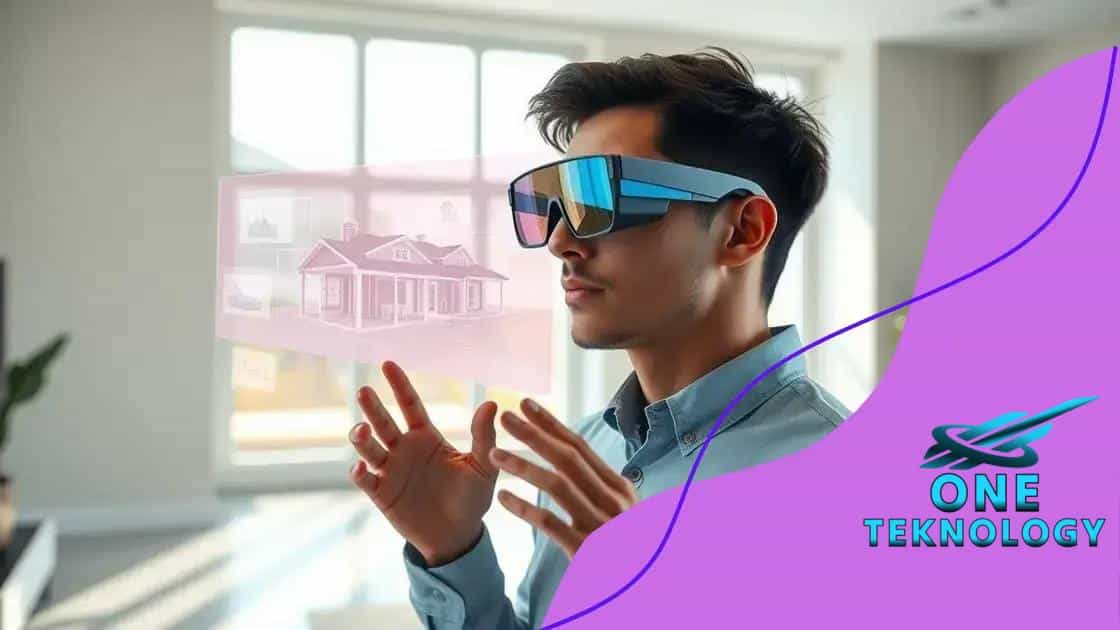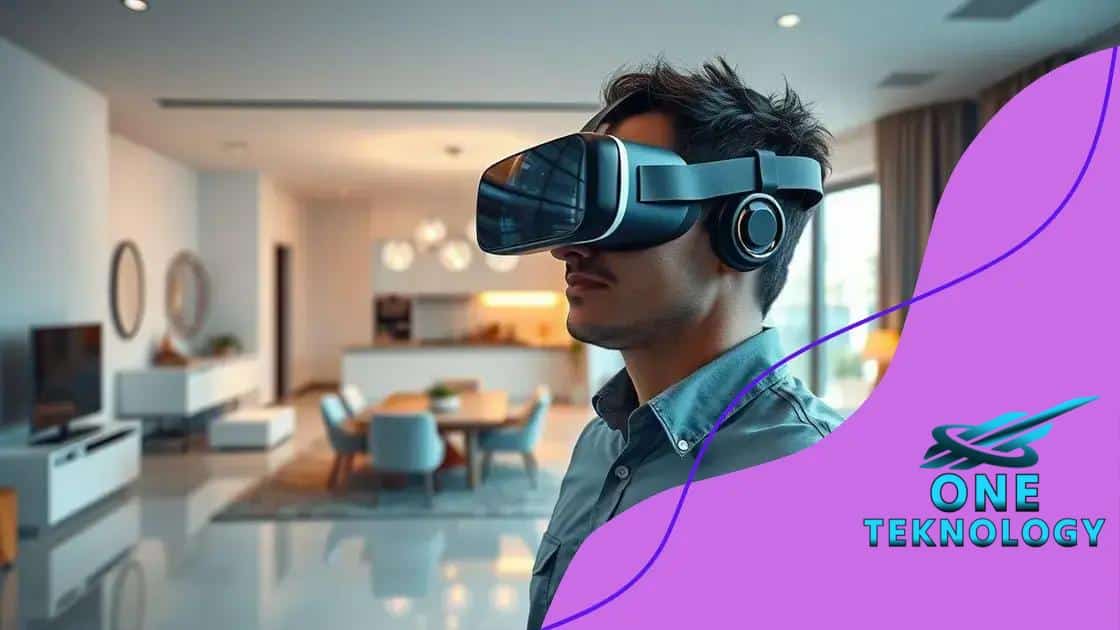How augmented reality is changing real estate marketing

Augmented reality is transforming real estate marketing by providing immersive experiences, customizable virtual tours, and valuable data insights that enhance buyer engagement and streamline the property buying process.
How augmented reality is changing real estate marketing is a game-changer in the industry. Imagine browsing homes as if you were actually there, all from your device! Let’s explore how this technology is reshaping the market.
Understanding augmented reality in real estate
Understanding augmented reality in real estate is crucial for anyone looking to enhance their marketing strategies. This technology allows buyers to interact with properties in ways never before possible, bringing the market to life for potential clients.
What is Augmented Reality?
Augmented reality (AR) overlays digital information onto the real world through devices like smartphones and AR glasses. This merging of physical and digital environments offers a unique experience for users, especially in real estate, where visualization is key.
How AR Benefits Real Estate
Using AR can significantly enhance property presentations. Imagine walking through a virtual home and seeing how different furniture placements would look right from your phone!
- Increased engagement: Buyers are more likely to interact with listings that use AR.
- Better visualization: Clients can see how a space can be transformed with their own taste.
- Time efficiency: AR reduces the number of in-person visits needed.
- Competitive edge: Properties with AR perspectives stand out in a crowded market.
For agents, it means providing a more compelling narrative around each property. Instead of static photos, clients can engage in an immersive experience that feels real and inviting.
As AR technology improves, its potential in real estate grows. The tools are becoming more accessible, allowing even smaller agencies to utilize this powerful marketing strategy.
Incorporating augmented reality into your marketing can also inform buyers more effectively about the unique features of a property. For instance, you can add interactive elements highlighting energy-efficient upgrades or historical details, engaging clients on a deeper level.
In summary, understanding how augmented reality functions within real estate will help you leverage its capabilities fully. This innovative approach not only attracts buyers but also educates them, making the purchasing process more enjoyable and straightforward.
Benefits of using augmented reality for marketing
The benefits of using augmented reality for marketing are numerous and impactful. By integrating this technology, businesses can reach customers in innovative ways. Imagine showcasing properties in a more engaging manner that captivates potential buyers.
Increased Customer Engagement
One of the main advantages is elevated customer engagement. Interactive experiences keep clients interested and curious about properties. This often leads to more inquiries and higher conversion rates.
- Engaging narratives: Clients can explore properties and their surroundings in depth.
- Enhanced storytelling: Deliver information about a property’s history and features in an immersive way.
- Memorable experiences: Unique interactions make listings unforgettable.
Furthermore, clients feel empowered with augmented reality tools. They can visualize changes, like furniture arrangements or color palettes, all from the comfort of their homes. This capability not only makes the buying process more fun but also helps buyers make informed decisions.
Streamlined Decision-Making
Another benefit lies in the ability to streamline decision-making. With AR, buyers can see multiple options instantly. For example, they can change wall colors or see how different furniture styles would look within the same space.
This quick access to information improves buyer confidence. When clients visualize a home transforming to fit their needs, they can proceed with less hesitation. In turn, this can speed up the closing process.
Also, using AR can tailor marketing materials to specific demographics. By providing visuals aligned with a target audience’s preferences, agencies can create more personalized experiences, improving overall satisfaction.
Adapting to augmented reality in marketing strategies reflects a commitment to innovation. Businesses that embrace this change are seen as forward-thinking and trustworthy, attracting more clients. This evolution in real estate marketing not only enhances visibility but also establishes deeper connections between buyers and properties.
How virtual tours enhance property listings

How virtual tours enhance property listings is a key topic in today’s real estate market. Virtual tours allow potential buyers to explore properties as if they were physically present, creating an immersive experience that traditional photos simply cannot match.
Immersive Experiences
With the use of virtual tours, buyers can engage with properties at their own pace. They can move through rooms, examine different angles, and appreciate the layout without needing to schedule a visit. This flexibility is vital, especially for long-distance buyers.
- Increased accessibility: Virtual tours are available 24/7, allowing anyone to view the property anytime.
- Enhanced understanding: Buyers can see how spaces flow together, helping them visualize living there.
- Engagement: An interactive experience holds attention longer than static images.
Moreover, using virtual tours can significantly broaden a property’s reach. Listings that include this feature often attract more views and lead to faster sales. Buyers appreciate being able to explore a home from the comfort of their own space.
Highlighting Key Features
Another important aspect of virtual tours is the ability to highlight key features of a property. Agents can use these tours to emphasize unique elements, like customized kitchens or expansive backyards. They can point out local amenities and the surrounding neighborhood as well.
This emphasis on specific details can dramatically affect a buyer’s perception. When they can virtually walk through a property and experience it fully, they are more likely to develop an emotional connection, which is essential in the purchasing process.
Additionally, virtual tours can showcase properties in a way that is tailored to different audiences. For instance, a luxury home can feature high-end finishes and stunning views, while a family home can highlight the spacious yard and nearby schools. This adaptability helps meet the diverse needs of potential buyers.
Incorporating virtual tours into property listings can change how buyers approach the mortgage or buying process. When prospective homeowners are fully informed and engaged, they make quicker decisions, and that benefits the sale timeline for real estate agents.
Case studies of successful augmented reality campaigns
Case studies of successful augmented reality campaigns show how this technology can transform real estate marketing. By examining real examples, we can understand the impact AR can have on attracting buyers and enhancing engagement.
Real Estate Example: Zillow 3D Home Tours
Zillow has embraced augmented reality with its 3D Home Tours feature. This allows prospective buyers to explore properties remotely. Users can navigate through each room, zoom in on details, and get a real feel for the space.
- Increased listings: Zillow reports that listings with 3D tours receive significantly more views compared to traditional listings.
- Higher engagement rates: Users spend more time on listings that feature AR technology.
- Enhanced user experience: Buyers feel more connected to the property without needing to step foot inside.
This campaign has made Zillow a go-to platform for many home buyers. It emphasizes how effective AR can be in simplifying the search process and encouraging faster decisions.
Example from REALTOR.com
Another impactful case study comes from REALTOR.com, which integrated AR features into their app. Their mobile users can use AR to visualize potential renovations and improvements in properties they are considering.
This innovative approach gives buyers a personalized experience. As a result, users can envision the property as their future home.
The campaign highlights how AR helps bridge the gap between imagination and reality, which is critical in the competitive real estate marketplace. The ability to visualize changes increases buyer confidence and encourages quicker offers.
Success in Educational Marketing: Matterport
Matterport takes a unique approach by offering extensive virtual tours for commercial properties. Their use of AR combined with detailed analytics allows property managers to attract tenants effectively.
- Comprehensive insights: Matterport provides data on user interactions and engagement statistics.
- Marketing tools: Their platform includes tools to create tailored virtual tours showing features important to specific tenants.
- Improved lead generation: Properties can attract leads who may not have otherwise considered the space.
These case studies illustrate the transformative potential of augmented reality in real estate marketing. By analyzing campaigns from industry leaders, we can appreciate the tangible benefits AR technology offers to agents and buyers alike.
Future trends in augmented reality for real estate
Future trends in augmented reality for real estate are exciting and full of potential. As technology evolves, AR is expected to become an even more integral part of the buying and selling process. This transformation will change how agents market properties and how buyers interact with them.
Enhanced User Experience
One trend we anticipate is the enhancement of user experiences through more interactive features. Future AR applications may allow clients to customize the virtual appearance of a property in real-time. Imagine being able to change wall colors, flooring options, or furniture layouts while exploring a listing.
- Virtual staging: AR could revolutionize property staging by providing a real-time view of how a home would look with different styles.
- Personalized experiences: Clients might receive tailored recommendations based on their preferences and previous interactions.
- Integration with smart home technology: AR could work alongside smart home platforms to showcase functionalities directly during virtual tours.
This level of customization will engage clients more deeply, making them feel more connected to the properties they are considering.
Greater Accessibility
Another significant trend is the increased accessibility of AR tools. As smartphone technology improves and becomes more affordable, augmented reality apps will become available to a broader audience. This growth will empower users to access property listings and virtual tours without needing expensive equipment.
With more people able to use augmented reality tools, we can expect an increase in engagement. Agents can reach potential buyers who may never visit a property in person, thus widening the market.
Data-Driven Insights
Future AR platforms will likely integrate advanced data analytics, allowing real estate professionals to gain insights into buyer behaviors. This information can be invaluable as agents will better understand what features attract buyers and can tailor their marketing strategies accordingly.
By analyzing how users interact with AR features, agents can refine their approaches to highlight the most appealing aspects of a property. This predictive capability will lead to more effective marketing strategies and quicker sales.
In conclusion, the future of augmented reality in real estate is bright and full of potential. As these technologies continue to develop, they will reshape the industry, making property transactions more engaging, accessible, and efficient.
In summary, the landscape of real estate marketing is rapidly evolving thanks to augmented reality. This technology enhances property listings, engages buyers, and personalizes experiences. As we move into the future, we can expect AR to become even more accessible and impactful. The integration of data analytics will provide real estate professionals with valuable insights into buyer preferences. By embracing these trends, agents can connect more effectively with clients and streamline the buying process. In a competitive market, leveraging AR will not only set real estate agents apart but will also enrich the entire purchasing journey for buyers.
FAQ – Frequently Asked Questions about Augmented Reality in Real Estate
How does augmented reality enhance property listings?
Augmented reality creates immersive experiences that allow potential buyers to explore properties in detail, making them more engaging compared to traditional photos.
What are the benefits of using virtual tours in real estate?
Virtual tours increase accessibility, allowing buyers to view properties at their convenience, regardless of their location, which can lead to faster sales.
Will augmented reality become more accessible to buyers?
Yes, as smartphone technology improves, augmented reality tools will be available to a wider audience, allowing more potential buyers to experience properties remotely.
How can data analytics improve augmented reality marketing?
Data analytics can provide insights into buyer preferences and behaviors, enabling agents to tailor their marketing strategies for better engagement and outcomes.






